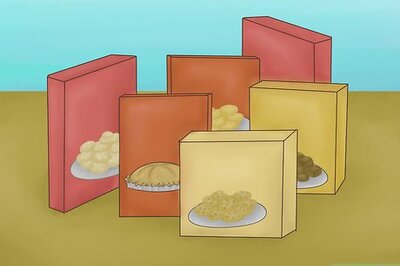
views
That a balanced diet consisting of nutrient-dense foods is vital for everything from weight loss to heart health is very well known. But here’s something to take note of ? you can get the most nutritious foods from the market and yet not increase your nutritional intake if you don’t focus on the crucial step between buying and eating, which is the cooking process.
Know the worst first
Choosing the right cooking method can help you maintain nutrient levels in your diet, which is why knowing which method is the best is necessary. Of course, if you are at all health-conscious, you’d know that deep frying is the worst cooking method out there. And no, choosing the right oil or ghee to deep fry in doesn’t make that much of a difference.
As a study published in Archivos Latinoamericanos de Nutricion in 2013 points out, deep frying involves oil-food interactions at very high temperatures. This interaction dehydrates the food, strips it of proteins, vitamins and minerals and introduces potentially toxic compounds to it. This is primarily because oil or fat of any kind oxidises and releases toxic substances when exposed to high temperatures, which is the hallmark of deep-frying.
Best cooking method
So, now that you know why deep-frying is the worst cooking method out there, it’s time to find out which is the best. A 2009 study in the Journal of Zhejiang University Science B analysed the nutritional value of broccoli after using five different methods to cook it ? microwaving, boiling, steaming, stir-frying and stir-frying followed by boiling. The researchers discovered that steaming was the only method that led to minimal nutritional loss.
So effective was this method that it even maintained the chlorophyll content of broccoli, apart from maintaining the levels of fiber, vitamins and minerals too. Another study in the International Journal of Gastronomy and Food Science in 2016 also concurs that steaming vegetables is the best method to maintain nutritional quality, including maintaining total antioxidant capacity, carotenoids, folate and phytochemicals.
Other healthy cooking methods
The same study also mentions that soaking vegetables, legumes, peas and grains in salt water, discarding the water after a while, and then cooking them can not only reduce cooking time and flush out toxins and microbes from these ingredients but also improve their protein content, texture, and reduce gastric issues. Some other healthy cooking methods you can use apart from steaming are:
1. Boiling: Cooking ingredients in hot water or other boiling liquids like stock is a good way to maintain nutritional levels, especially if you don’t drain out the excess water. On the other hand, boiling rice in excess water then draining it can get rid of any arsenic.
2. Baking: When you use an oven, it cooks the food at a low yet even heat and maintains the moisture as well as the nutritional content of the food. Roasting or grilling at high temperatures, however, can be very harmful.
3. Poaching and blanching: Both these methods also involve cooking in a hot liquid instead of cooking on direct heat and maintain nutrient quality and content well. Poaching means cooking by immersing an ingredient (usually eggs, fish, chicken or vegetables) in simmering water. Blanching means soaking ingredients in hot water away which is not on direct heat and is used on vegetables and even nuts like almonds.
Other cooking methods like sauteing, stir-frying and broiling are not as unhealthy as deep-frying but should be avoided as much as possible. Microwaving is convenient and quick, but not recommended for consistent use since it involves exposure to radiation.
For more information, read our article on Healthy recipes.
Health articles on News18 are written by myUpchar.com, India’s first and biggest resource for verified medical information. At myUpchar, researchers and journalists work with doctors to bring you information on all things health.


















Comments
0 comment